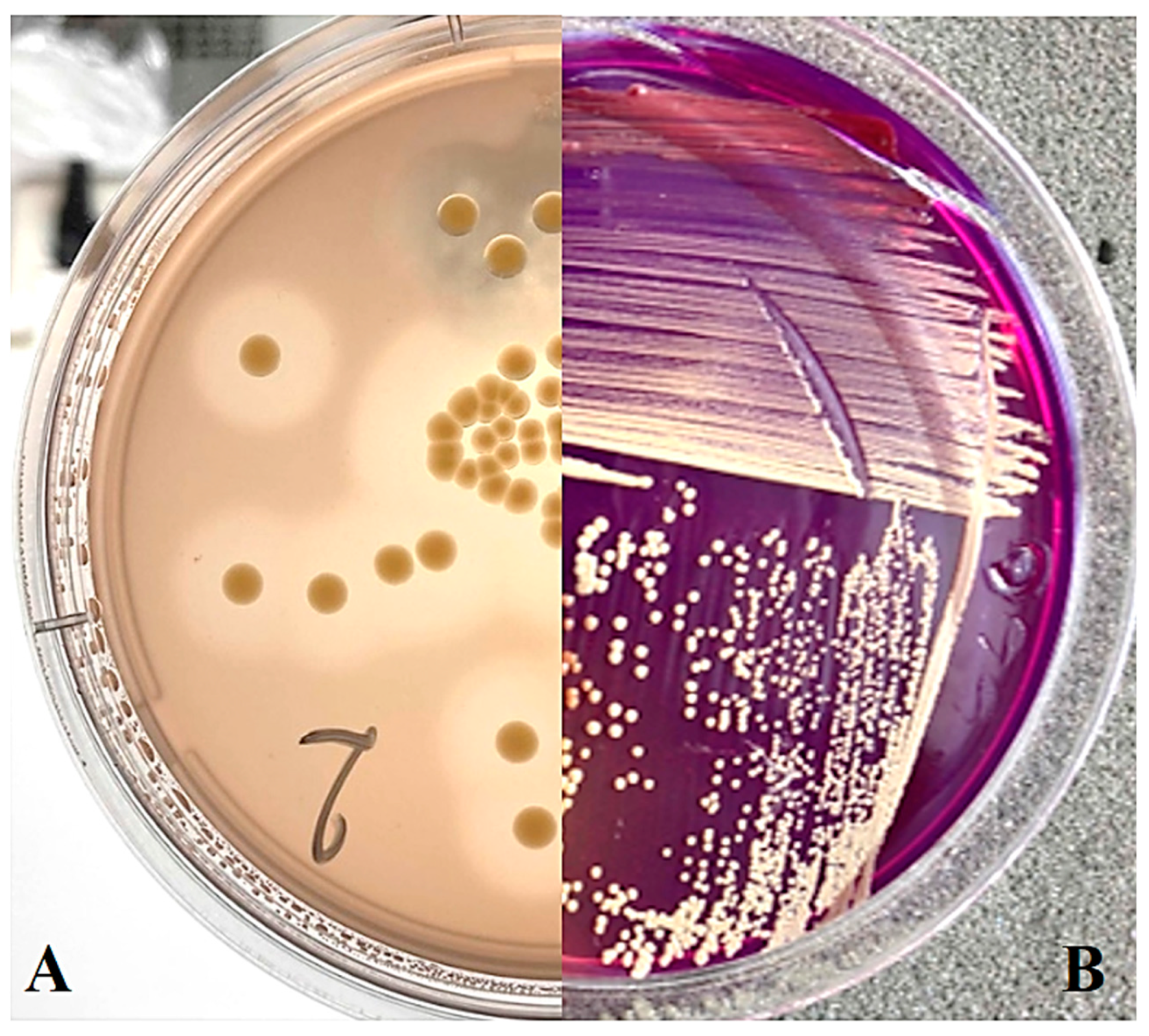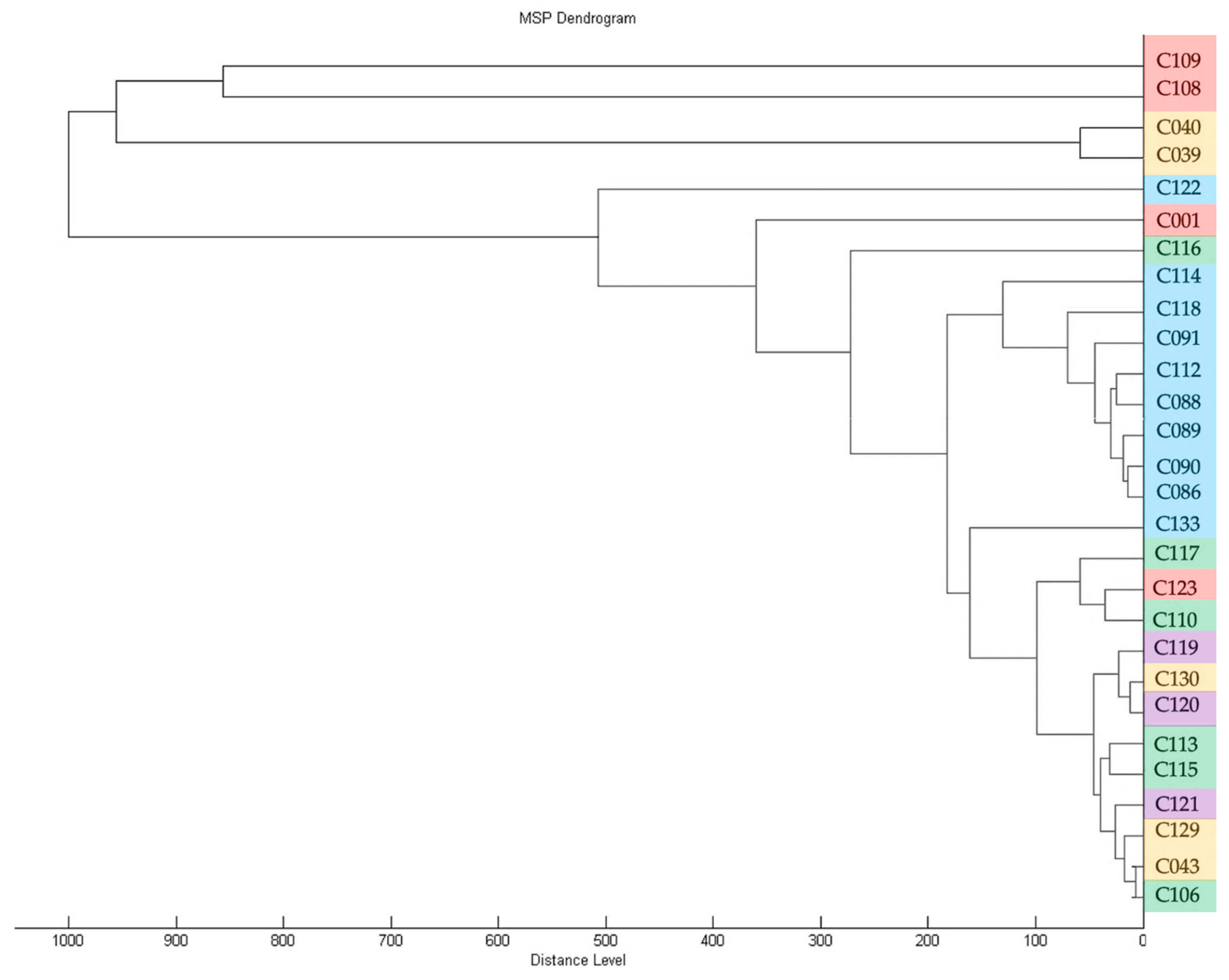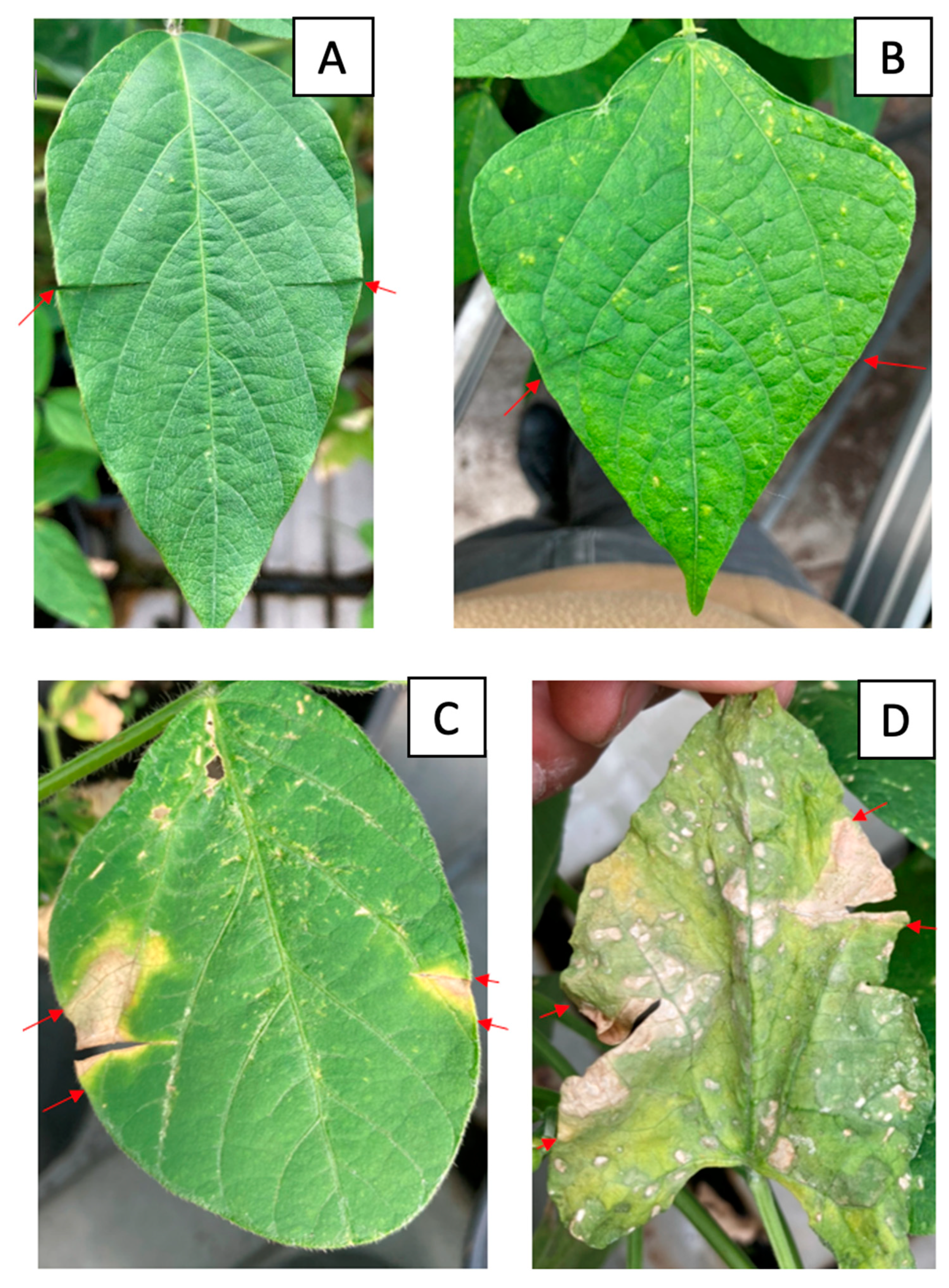Phytopathogenic Curtobacterium flaccumfaciens Strains Circulating on Leguminous Plants, Alternative Hosts and Weeds in Russia
Abstract
1. Introduction
2. Results
2.1. Isolation and Phenotypic Characteristics of Bacterial Strains
2.2. Genetic Diversity and Phylogeny of Isolated Strains
2.2.1. BOX Fingerprinting
2.2.2. Phylogeny
2.2.3. MALDI-TOF MS Analysis
2.3. Plant Pathogenicity and Resistance to Bacteriocides
2.3.1. Pathogenicity Tests
2.3.2. Susceptibility of Cff Strains to Copper Compounds
3. Discussion
4. Materials and Methods
4.1. Bacterial Strains: Isolation and Growth Conditions
4.2. DNA Extraction
4.3. Molecular Identification of Isolated Strains
4.4. Genetic Fingerprinting
4.5. Sequencing and Analysis of Alanine Synthetase
4.6. Phylogenetic Analysis
4.7. MALDI-TOF
4.8. Biochemical Characterisation of Curtobacterium Strains
4.9. Pathogenicity Tests
4.10. Susceptibility of Bacterial Strains to Copper Hydroxide
4.11. Statistical Analysis
Supplementary Materials
Author Contributions
Funding
Data Availability Statement
Conflicts of Interest
References
- FAO. World Food and Agriculture—Statistical Yearbook 2023; FAO: Rome, Italy, 2023; ISBN 978-92-5-138262-2. [Google Scholar]
- Rubiales, D.; Fondevilla, S.; Chen, W.; Gentzbittel, L.; Higgins, T.J.V.; Castillejo, M.A.; Singh, K.B.; Rispail, N. Achievements and Challenges in Legume Breeding for Pest and Disease Resistance. Crit. Rev. Plant Sci. 2015, 34, 195–236. [Google Scholar] [CrossRef]
- Dell’Olmo, E.; Tiberini, A.; Sigillo, L. Leguminous Seedborne Pathogens: Seed Health and Sustainable Crop Management. Plants 2023, 12, 2040. [Google Scholar] [CrossRef]
- Collins, M.D.; Jones, D. Reclassification of Corynebacterium flaccumfaciens, Corynebacterium betae, Corynebacterium oortii and Corynebacterium poinsettiae in the Genus Curtobacterium, as Curtobacterium flaccumfaciens Comb. Nov. Microbiology 1983, 129, 3545–3548. [Google Scholar] [CrossRef][Green Version]
- Osdaghi, E.; Young, A.J.; Harveson, R.M. Bacterial Wilt of Dry Beans Caused by Curtobacterium flaccumfaciens pv. flaccumfaciens: A New Threat from an Old Enemy. Mol. Plant Pathol. 2020, 21, 605–621. [Google Scholar] [CrossRef] [PubMed]
- Hedges, F. A Bacterial Wilt of the Bean Caused by Bacterium flaccumfaciens Nov. Sp. Science 1922, 55, 433–434. [Google Scholar] [CrossRef] [PubMed]
- Harveson, R.M.; Schwartz, H.F.; Urrea, C.A.; Yonts, C.D. Bacterial Wilt of Dry-Edible Beans in the Central High Plains of the U.S.: Past, Present, and Future. Plant Dis. 2015, 99, 1665–1677. [Google Scholar] [CrossRef]
- Allen, D.J. An Annotated List of Diseases, Pathogens and Associated Fungi of the Common Bean (Phaseolus vulgaris) in Eastern and Southern Africa; CAB International: Wallingford, UK, 1995. [Google Scholar]
- Tarakanov, R.I.; Lukianova, A.A.; Pilik, R.I.; Evseev, P.V.; Miroshnikov, K.A.; Dzhalilov, F.S.-U.; Tesic, S.; Ignatov, A.N. First Report of Curtobacterium flaccumfaciens pv. flaccumfaciens Causing Bacterial Tan Spot of Soybean in Russia. Plant Dis. 2023, 107, 2211. [Google Scholar] [CrossRef] [PubMed]
- Nikitina, K.V.; Korsakov, N.I. Bacterial diseases of soybean in the Soviet Far East and in southern regions of the USSR: Search for sources of resistance to them. Tr. Prikl. Bot. Genet. Sel. 1978, 62, 13–18. [Google Scholar]
- Pilik, R.; Tesic, S.; Ignatov, A.N.; Tarakanov, R.I.; Dorofeeva, L.V.; Lukyanova, A.A.; Evseev, P.V.; Dzhalilov, F.S.-U.; Miroshnikov, K.A. First Report of Curtobacterium flaccumfaciens pv. flaccumfaciens Causing Bacterial Wilt and Blight on Sunflower in Russia. Plant Dis. 2023, 107, 1621. [Google Scholar] [CrossRef]
- EFSA Panel on Plant Health (EFSA PLH Panel); Jeger, M.; Bragard, C.; Caffier, D.; Candresse, T.; Chatzivassiliou, E.; Dehnen-Schmutz, K.; Gilioli, G.; Grégoire, J.-C.; Jaques Miret, J.A.; et al. Pest Categorisation of Curtobacterium flaccumfaciens pv. flaccumfaciens. EFSA J. 2018, 16, e05299. [Google Scholar] [CrossRef]
- Patyka, V.P. Phytopathogenic Bacteria in Contemporary Agriculture. Mikrobiol. Z. 2016, 78, 71–83. [Google Scholar] [CrossRef]
- Gnatiuk, T.T.; Zhitkevich, N.V.; Gritsaĭ, R.V.; Patyka, V.F. Curtobacterium flaccumfaciens pv. flaccumfaciens is the agent of bacterial disease of soybean. Mikrobiol. Z. 2013, 75, 22–27. [Google Scholar]
- Wang, Y.; Jin, L.; Lu, P.; Zhang, L. First Report of Bacterial Leaf Spot Caused by Curtobacterium flaccumfaciens on Dendrobium officinale Kimura et Migo in China. Plant Dis. 2016, 100, 515. [Google Scholar] [CrossRef]
- Du, X.; Hu, Y.; He, W.; Chen, G.; Wang, T.; Qiu, Y.; Wang, Y. Correlation of bacterial diversity in rot Chinese cabbage with the habitat. Wei Sheng Wu Xue Bao 2011, 51, 1639–1645. [Google Scholar] [PubMed]
- Nascimento, D.M.; Oliveira, L.R.; Melo, L.L.; Silva, J.C.; Soman, J.M.; Girotto, K.T.; Eburneo, R.P.; Ribeiro-Junior, M.R.; Sartori, M.M.P.; Silva Júnior, T.A.F.; et al. Survival of Curtobacterium flaccumfaciens pv. flaccumfaciens in Weeds. Plant Pathol. 2020, 69, 1357–1367. [Google Scholar] [CrossRef]
- Evseev, P.; Lukianova, A.; Tarakanov, R.; Tokmakova, A.; Shneider, M.; Ignatov, A.; Miroshnikov, K. Curtobacterium spp. and Curtobacterium flaccumfaciens: Phylogeny, Genomics-Based Taxonomy, Pathogenicity, and Diagnostics. Curr. Issues Mol. Biol. 2022, 44, 889–927. [Google Scholar] [CrossRef]
- Tegli, S.; Sereni, A.; Surico, G. PCR-based Assay for the Detection of Curtobacterium flaccumfaciens pv. flaccumfaciens in Bean Seeds. Lett. Appl. Microbiol. 2002, 35, 331–337. [Google Scholar] [CrossRef]
- EPPO. OEPP/EPPO PM 7/100(1): Rep-PCR Tests for Identification of Bacteria. Bulletin OEPP/EPPO 2010, 40, 365–368. [Google Scholar] [CrossRef]
- Louws, F.J.; Fulbright, D.W.; Stephens, C.T.; de Bruijn, F.J. Specific Genomic Fingerprints of Phytopathogenic Xanthomonas and Pseudomonas Pathovars and Strains Generated with Repetitive Sequences and PCR. Appl. Environ. Microbiol. 1994, 60, 2286–2295. [Google Scholar] [CrossRef]
- Marques, A.; Marchaison, A.; Gardan, L.; Samson, R. BOX-PCR-Based Identification of Bacterial Species Belonging to Pseudomonas Syringae-P. Viridiflava Group. Genet. Mol. Biol. 2008, 31. [Google Scholar] [CrossRef][Green Version]
- Chase, A.B.; Arevalo, P.; Polz, M.F.; Berlemont, R.; Martiny, J.B.H. Evidence for Ecological Flexibility in the Cosmopolitan Genus Curtobacterium. Front. Microbiol. 2016, 7, 1874. [Google Scholar] [CrossRef] [PubMed]
- Gonçalves, R.M.; Balbi-Peña, M.I.; Soman, J.M.; Maringoni, A.C.; Taghouti, G.; Fischer-Le Saux, M.; Portier, P. Genetic Diversity of Curtobacterium flaccumfaciens Revealed by Multilocus Sequence Analysis. Eur. J. Plant Pathol. 2019, 154, 189–202. [Google Scholar] [CrossRef]
- Na, S.-I.; Kim, Y.O.; Yoon, S.-H.; Ha, S.-M.; Baek, I.; Chun, J. UBCG: Up-to-Date Bacterial Core Gene Set and Pipeline for Phylogenomic Tree Reconstruction. J. Microbiol. 2018, 56, 280–285. [Google Scholar] [CrossRef] [PubMed]
- Gonçalves, R.M.; Schipanski, C.A.; Koguishi, L.; Soman, J.M.; Sakate, R.K.; Júnior, T.A.F.S.; Maringoni, A.C. Alternative Hosts of Curtobacterium flaccumfaciens pv. flaccumfaciens, Causal Agent of Bean Bacterial Wilt. Eur. J. Plant Pathol. 2017, 148, 357–365. [Google Scholar] [CrossRef]
- Osdaghi, E.; Taghavi, S.M.; Hamzehzarghani, H.; Fazliarab, A.; Harveson, R.M.; Tegli, S.; Lamichhane, J.R. Epiphytic Curtobacterium flaccumfaciens Strains Isolated from Symptomless Solanaceous Vegetables Are Pathogenic on Leguminous but Not on Solanaceous Plants. Plant Pathol. 2018, 67, 388–398. [Google Scholar] [CrossRef]
- Maringoni, A.C.; Souza, E.L.C. de Reação de cultivares de soja a isolado de Curtobacterium flaccumfaciens pv. flaccumfaciens, proveniente de feijoeiro. Pesq. Agropec. Bras. 2003, 38, 777–781. [Google Scholar] [CrossRef][Green Version]
- Estefani, R.C.C.; Miranda Filho, R.J.; Uesugi, C.H. Tratamentos térmico e químico de sementes de feijoeiro: Eficiência na erradicação de Curtobacterium flaccumfaciens pv. flaccumfaciens e efeitos na qualidade fisiológica das sementes. Fitopatol. Bras. 2007, 32, 434–438. [Google Scholar] [CrossRef]
- Goto, M.; Hikota, T.; Nakajima, M.; Takikawa, Y.; Tsuyumu, S. Occurrence and Properties of Copper-Resistance in Plant Pathogenic Bacteria. Jpn. J. Phytopathol. 1994, 60, 147–153. [Google Scholar] [CrossRef]
- Fatmi, M.; Walcott, R.R.; Schaad, N.W. Detection of Plant-Pathogenic Bacteria in Seed and Other Planting Material; APS Publications: St. Paul, MN, USA, 2017. [Google Scholar]
- Maringoni, A.C.; Camara, R.C.; Souza, V.L. Semi-Selective Culture Medium for Curtobacterium flaccumfaciens pv. flaccumfaciens Isolation from Bean Seeds. Seed Sci. Technol. 2006, 34, 117–124. [Google Scholar] [CrossRef]
- Tegli, S.; Surico, G.; Esposito, A. Studi Sulla Diagnosi Di Curtobacterium flaccumfaciens pv. flaccumfaciens Nei Semi Di Fagiolo. Not. Sulla Prot. Delle Piante 1998, 9, 63–71. [Google Scholar]
- Pavel, A.B.; Vasile, C.I. PyElph—A Software Tool for Gel Images Analysis and Phylogenetics. BMC Bioinform. 2012, 13, 9. [Google Scholar] [CrossRef] [PubMed]
- Katoh, K.; Standley, D.M. MAFFT Multiple Sequence Alignment Software Version 7: Improvements in Performance and Usability. Mol. Biol. Evol. 2013, 30, 772–780. [Google Scholar] [CrossRef] [PubMed]
- Nguyen, L.-T.; Schmidt, H.A.; von Haeseler, A.; Minh, B.Q. IQ-TREE: A Fast and Effective Stochastic Algorithm for Estimating Maximum-Likelihood Phylogenies. Mol. Biol. Evol. 2015, 32, 268–274. [Google Scholar] [CrossRef] [PubMed]
- Letunic, I.; Bork, P. Interactive Tree Of Life (iTOL) v5: An Online Tool for Phylogenetic Tree Display and Annotation. Nucleic Acids Res. 2021, 49, W293–W296. [Google Scholar] [CrossRef]
- Dorofeeva, L.V.; Starodumova, I.P.; Krauzova, V.I.; Prisyazhnaya, N.V.; Vinokurova, N.G.; Lysanskaya, V.Y.; Tarlachkov, S.V.; Evtushenko, L.I. Rathayibacter oskolensis Sp. Nov., a Novel Actinobacterium from Androsace koso-poljanskii Ovcz. (Primulaceae) Endemic to the Central Russian Upland. Int. J. Syst. Evol. Microbiol. 2018, 68, 1442–1447. [Google Scholar] [CrossRef] [PubMed]
- Vidaver, A.K. Synthetic and Complex Media for the Rapid Detection of Fluorescence of Phytopathogenic Pseudomonads: Effect of the Carbon Source. Plant Pathol. 1967, 59, 1523–1524. [Google Scholar] [CrossRef] [PubMed]
- dela Cruz, T.E.E.; Torres, J.M.O. Gelatin Hydrolysis Test Protocol. Am. Soc. Microbiol. 2012, 1, 1–10. [Google Scholar]
- Hsieh, T.F.; Huang, H.C.; Mündel, H.H.; Erickson, R.S. A Rapid Indoor Technique for Screening Common Bean (Phaseolus vulgaris L.) for Resistance to Bacterial Wilt [Curtobacterium flaccumfaciens pv. flaccumfaciens (Hedges) Collins and Jones]. Rev. Mex. Fitopatol. 2003, 21, 370–374. [Google Scholar]
- Eddin, K.S.; Marimuthu, T.; Ladhalakshmi, D.; Rabindran, R.; Velazhahan, R. A Simple Inoculation Technique for Evaluation of Cotton Genotypes for Resistance to Bacterial Blight Caused by Xanthomonas axonopodis pv. malvacearum. J. Plant Dis. Prot. 2005, 112, 321–328. [Google Scholar]
- Puia, J.D.; Murari, R.R.; Borsato, L.C.; Sugahara, V.H.; da Silva Machineski, G.; Canteri, M.G.; Vigo, S.C. Protocol for Detecting Curtobacterium flaccumfaciens pv. flaccumfaciens in the Leaves of Infected Bean Plants (Phaseolus vulgaris L.). Acta Sci. Agron. 2021, 43. [Google Scholar] [CrossRef]
- CLSI. Methods for Dilution Antimicrobial Susceptibility Tests for Bacteria That Grow Aerobically, 10th ed.; Approved Standard; Clinical and Laboratory Standards Institute: Wayne, PA, USA, 2015. [Google Scholar]







| No | Strain | Name | Origin | Year |
|---|---|---|---|---|
| Pathogenic Strains from Cultivated Plants | ||||
| 1 | C034 | SF20 | Sunflower, Kursk region | 2018 |
| 2 | C035 | SF21 | 2018 | |
| 3 | C036 | SF22 | 2018 | |
| 4 | C037 | SF23 | 2018 | |
| 5 | C038 | SF24 | 2018 | |
| 6 | C039 | SF25 | 2021 | |
| 7 | C040 | SF26 | 2021 | |
| 8 | C043 | Curt3 | Tomato, Moscow region | 2021 |
| 9 | C086 | F125-1 | Soybean, cv. Kasatka, Ryazan region | 2021 |
| 10 | C087 | F125-2 | 2021 | |
| 11 | C088 | F125-3 | 2021 | |
| 12 | C089 | F30-1 | Soybean, cv. Dauria, Amur Region | 2021 |
| 13 | C090 | F30-2 | 2021 | |
| 14 | C091 | F30-3 | 2021 | |
| 15 | C137 | 362 | Wheat, Moscow region | 2022 |
| 16 | C138 | 429 | Apple tree seedlings, Moscow region | 2022 |
| 17 | C139 | 507 | Pea, Moscow region | 2022 |
| 18 | C142 | 44 | Soybean cv. Nordica, Belgorod region | 2022 |
| 19 | C144 | 19 | Soybean, cv. Sultana, Novosibirsk region | 2022 |
| Strains from Wild Plants | ||||
| 20 | C108 | 414DL | Ground elder (Aegopódium podagrária), Moscow region | 2020 |
| 21 | C109 | 557DL | A. podagrária, Moscow region | 2020 |
| 22 | C110 | 412DL | 2020 | |
| 23 | C112 | 329DL | Sow thistle (Sonchus sp.), Moscow region | 2020 |
| 24 | C113 | 415DL | A. podagrária, Moscow region | 2020 |
| 25 | C114 | 367DL | Sonchus sp., Moscow region | 2020 |
| 26 | C115 | 411DL | A. podagrária, Moscow region | 2020 |
| 27 | C116 | 575DL | 2020 | |
| 28 | C117 | 571DL | 2020 | |
| 29 | C118 | 332DL | Sonchus sp., Moscow region | 2020 |
| 30 | C122 | 144DL | 2020 | |
| 31 | C123 | 570DL | A. podagrária, Moscow region | 2020 |
| 32 | C129 | 53150 | Yellow melilot (Melilótus officinális), Krasnodar region | 2019 |
| 33 | C130 | 400DL | A. podagrária, Moscow region | 2020 |
| Reference Strains | ||||
| 34 | C001 | Ac-1923 (DSM 20129 ATCC 6887, NCTC 4758) | Common bean (Phaseolus vulgaris) | before 1990 |
| 35 | C106 | 52862 = VKM Ac-2861 | Marah sp., California, USA | 2019 |
| 36 | C119 | 53223 | American beech (Fagus grandifolia), New York, USA | 2019 |
| 37 | C120 | 53217 | F. grandifolia, New York, USA | 2019 |
| 38 | C121 | 53256 | Agrostis capillaris, nematode Anguina agrostis, Washington, USA | 2020 |
| 39 | C133 | 53258 = VKM Ac-2884 | 2020 | |
Disclaimer/Publisher’s Note: The statements, opinions and data contained in all publications are solely those of the individual author(s) and contributor(s) and not of MDPI and/or the editor(s). MDPI and/or the editor(s) disclaim responsibility for any injury to people or property resulting from any ideas, methods, instructions or products referred to in the content. |
© 2024 by the authors. Licensee MDPI, Basel, Switzerland. This article is an open access article distributed under the terms and conditions of the Creative Commons Attribution (CC BY) license (https://creativecommons.org/licenses/by/4.0/).
Share and Cite
Tokmakova, A.D.; Tarakanov, R.I.; Lukianova, A.A.; Evseev, P.V.; Dorofeeva, L.V.; Ignatov, A.N.; Dzhalilov, F.S.-U.; Subbotin, S.A.; Miroshnikov, K.A. Phytopathogenic Curtobacterium flaccumfaciens Strains Circulating on Leguminous Plants, Alternative Hosts and Weeds in Russia. Plants 2024, 13, 667. https://doi.org/10.3390/plants13050667
Tokmakova AD, Tarakanov RI, Lukianova AA, Evseev PV, Dorofeeva LV, Ignatov AN, Dzhalilov FS-U, Subbotin SA, Miroshnikov KA. Phytopathogenic Curtobacterium flaccumfaciens Strains Circulating on Leguminous Plants, Alternative Hosts and Weeds in Russia. Plants. 2024; 13(5):667. https://doi.org/10.3390/plants13050667
Chicago/Turabian StyleTokmakova, Anna D., Rashit I. Tarakanov, Anna A. Lukianova, Peter V. Evseev, Lyubov V. Dorofeeva, Alexander N. Ignatov, Fevzi S.-U. Dzhalilov, Sergei A. Subbotin, and Konstantin A. Miroshnikov. 2024. "Phytopathogenic Curtobacterium flaccumfaciens Strains Circulating on Leguminous Plants, Alternative Hosts and Weeds in Russia" Plants 13, no. 5: 667. https://doi.org/10.3390/plants13050667
APA StyleTokmakova, A. D., Tarakanov, R. I., Lukianova, A. A., Evseev, P. V., Dorofeeva, L. V., Ignatov, A. N., Dzhalilov, F. S.-U., Subbotin, S. A., & Miroshnikov, K. A. (2024). Phytopathogenic Curtobacterium flaccumfaciens Strains Circulating on Leguminous Plants, Alternative Hosts and Weeds in Russia. Plants, 13(5), 667. https://doi.org/10.3390/plants13050667











